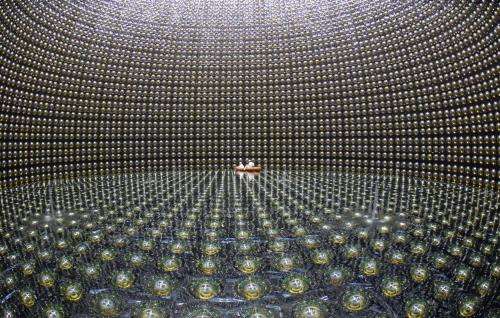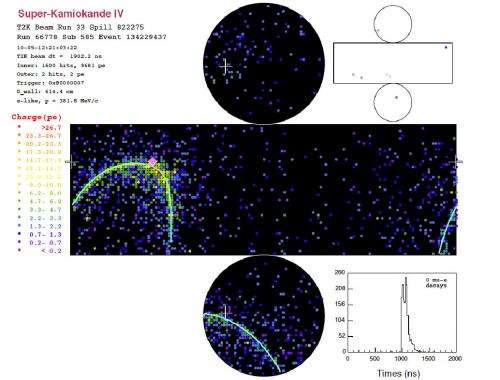Credit: Univeristy of Tokyo
(PhysOrg.com) -- Where did all the matter in the universe come from? This is one of the biggest mysteries in fundamental physics and exciting results released on 15 June 2011 from the international T2K neutrino experiment in Japan could be an important step towards resolving this puzzle.
The intriguing results indicate a new property of the enigmatic particles known as neutrinos.
There are three types of neutrinos (called flavours) - one paired by particle interactions with the familiar electron (called the electron neutrino), and two more paired with the electron's heavier cousins, the muon and tau leptons. Previous experiments around the world have shown that these different flavours of neutrinos can spontaneously change into each other, a phenomenon called 'neutrino oscillation'.
Two types of oscillations have already been observed but in its first full period of operation, the T2K experiment has already seen evidence for a new type of oscillation (the appearance of electron neutrinos in a muon neutrino beam). This means that we have now observed that neutrinos can oscillate in every way possible.
This level of complexity opens the possibility that the oscillations of neutrinos and their anti-particles (called anti-neutrinos) could be different. And if the oscillations of neutrinos and anti-neutrinos are different, it would be an example of what physicists call CP violation. This could be the key to explaining why there is more matter than anti-matter in the universe (an excess which could not happen within the known laws of physics).
The experiment ran from January 2010 until 11 March this year, when it was dramatically interrupted by the Japanese earthquake. Fortunately, the multinational T2K team were unharmed and their highly sensitive detectors were largely undamaged. Six clean electron neutrino events are observed in the data from before the earthquake, while in the absence of oscillations there should only have been 1.5. Even though such an excess could only happen by chance about one time in a hundred, that is not good enough to confirm a new physics discovery, so this is called an 'indication'.
Prof Dave Wark of STFC and Imperial College London, who served for four years as the International Co-Spokesperson of the experiment and is head of the UK group, explains, "People sometimes think that scientific discoveries are like light switches that click from 'off' to 'on', but in reality it goes from 'maybe' to 'probably' to 'almost certainly' as you get more data. Right now we are somewhere between 'probably' and 'almost certainly'."
In this projected diagram of cylinder-shaped Super-Kamiokande, each coloured dot shows a photomultiplier that detected light (these photomultipliers are mounted on the inside wall of the detector). Electron neutrinos interact with water in the detector to produce electrons, which subsequently induce electromagnetic showers to eventually emit Cherenkov light that is detected in a ring-shaped structure.
Prof Christos Touramanis from Liverpool University is the Project Manager for the UK contributions to T2K: "We have examined the near detectors and turned some of them back on, and everything that we have tried works pretty well. So far it looks like our earthquake engineering was good enough, but we never wanted to see it tested so thoroughly."
Prof Takashi Kobayashi of the KEK Laboratory in Japan and spokesperson for the T2K experiment, said "It shows the power of our experimental design that with only 2% of our design data we are already the most sensitive experiment in the world for looking for this new type of oscillation."
About T2K
The experiment is a huge undertaking with over 500 scientists from 12 countries. The UK has invested £14.3M in the T2K project.
There are three elements to the experiment:
• A beam of muon neutrinos is produced at the Japan Proton Accelerator Research Center in Tokai, Japan. STFC engineers from the Rutherford Appleton Laboratory helped in the design, production, and testing of a number of the elements of this neutrino production system.
• The neutrinos then pass through a complex set of near detectors located 280 meters from the target in order to determine the neutrino beam's composition and properties before the neutrinos have a chance to oscillate. 8 STFC-supported institutions (listed below) were involved in the production of a variety of components for these near detectors.
• The neutrinos then fly under the ground for 295 km across Japan to the mammoth Super Kamiokande neutrino detector (a tank of 50,000 tons of ultra-pure water surrounded by sensitive optical detectors which can see the very faint flashes of light emitted by the very rare interactions of passing neutrinos with the water). This is capable of telling muon neutrinos from electron neutrinos with high precision, and is thus ideal for looking for the appearance of a small fraction of electron neutrinos appearing in the muon neutrino beam, the key signature of this new type of oscillation.
More information: jnusrv01.kek.jp/public/t2k/
Provided by Science and Technology Facilities Council























